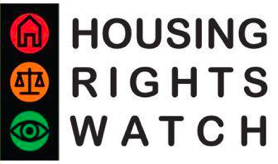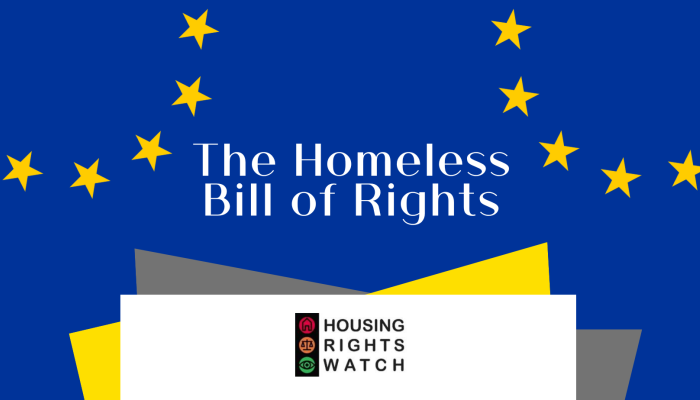Ane Aranguiz
PhD Researcher (FWO), University of Antwerp, Faculty of law
After presenting the initiative in March 2016 for public consultation, the European Commission officially launched the long awaited European Pillar of Social Rights on April 26 2017. The Pillar presents a total of 20 principles which aim to deliver new and more effective rights to citizens. Among these twenty principles, the right to housing has been given a place in Principle 19 which aims to provide housing and emphasises three areas: a) Access to social housing or housing assistance of good quality for those in need; b) vulnerable people’s right to appropriate assistance and protection against forced eviction; and c) adequate shelter and services for the homeless in order to promote their social inclusion.[1]
The provision builds upon Article 34(3) of the Charter of Fundamental Rights of the European Union (CFEU) which recognises the right to social and housing assistance, in order to ensure a decent existence for all those who lack sufficient resources.[2] However, the Principle goes beyond the Charter by guaranteeing not only the right to housing assistance but also access to social housing. This provision would therefore include an ample range of possibilities inter alia, housing benefits, income support, rental disabilities and tax reductions. The personal scope of the Principle is also wider than that one in the CFEU, including housing assistance to everyone in need, and not only to those lacking sufficient resources. This is essential for those with special needs, from disabilities to family breakdowns.
As far as the right to appropriate assistance and protection against forced eviction is concerned, once again, the Pillar provides for a substantial reinforcement of the right to housing, which would be represented by different forms of protection including affordable legal aid and protective measures, such as access to debt management schemes.
Notably, the Pillar extends the right to access to adequate shelter to everyone in a situation of homelessness. This right is to be understood in terms of affordability, security of tenure, habitability, accessibility, location and cultural adequacy. What is more, the principle sets a broader right by referring to the promotion of social inclusion.[3]
In addition to principle 19, several other provisions of the Pillar have a significant impact with regard to homelessness and housing exclusion. Of particular importance for housing rights is the section of principle 20 which provides for every individual the right to access to essential services of good quality, which include, inter alia, water sanitation, energy, transport, financial services and digital communications. In addition to this, a number of other provisions within the Pillar are directly connected to the right to housing, among others, equal treatment, social protections, minimum income and unemployment benefits.
Although the initiative of the Commission to include housing rights, and other relevant provisions, within the principles has been warmly welcomed, a point of concern is that of the legal nature of the principles. The principles and rights enshrined in the Pillar are not directly enforceable and they require a translation into dedicated action and pieces of legislation. In the case of principle 19, and with regard to Member States, they are invited to adopt measures in order to support universal access to shelter. At the EU level, however, the principle is to be implemented within the European Semester -the annual cycle of governance in the EU- with the support of the so-called Social Open Method Coordination (OMC) to enhance policy coordination and monitor the progress of Member States.
The Pillar was presented in the form of a Recommendation alongside a proposal for an interinstitutional proclamation. As such, the Pillar represents a framework for guiding future action by the Member States involved. The establishment of the Pillar will therefore remain mainly within the competence of national and local authorities. The EU will however look for further forms to enhance Member States’ action by virtue of available tools at EU level.
With this in mind, the launch of the Pillar was additionally accompanied by a first set of legislative initiatives among which was access to social protection. For this initiative, the Commission is starting a consultation of social partners to define possible new rules in this area. Notably, the Commission anticipated undertaking further initiatives in areas covered by the Pillar following the process of preparation and discussion of the annual Commission Work Programme.[4]
It is highly important to take advantage of the available legal basis under the current EU treaties for the implementation of secondary legislation, mainly those of binding nature- i.e. directives and regulations- in order to start the path towards parity between social and economic policy. This raises the question on whether the EU has the competence to adopt such legally binding measures. Even though housing rights as such are not a formal competence of the Union, there are a number of tools in the treaties which relate to the right to housing. For a legally binding tool, this could refer to the Social Policy Title in the Treaty of Functioning of the European Union (TFEU), more specifically Article 153(1)(h) which entitles the Union to adopt binding measures using an ordinary legislative procedure for the integration of persons excluded from the labour market. This provision could be used as a basis for, for example, an EU Framework Directive on Minimum Income, which would significantly improve the overall situation of those at risk of poverty or social exclusion. Although this provision would in principle only apply to those persons excluded from the labour market, while in-work poverty is becoming increasingly common, such a Directive would likely catalyse a Framework Directive on Minimum Income for all.
While the report on the public consultation of the Pillar collects the idea of intervening through legally binding instruments, this was subject to little discussion during the High-Level Conference, which for those with a more pessimistic view, could imply unwillingness by the Commission to make hard law proposals. Others have taken it a step further and suggested that the legal nature of the Pillar is irrelevant since the real problem behind the lack of protection of social rights lies in the reluctance of the EU institutions to implement such measures:
The legal basis on which the EPSR rests already has the status of quasi-constitutional primary law. Yet, those provisions have not prevented the EU from ignoring, circumventing and even directly violating fundamental social rights. Thus, the real problem is not the legal status of existing provisions but the total and wilful ignorance of these principles.[5]
Arguably, I am of the opinion that anchoring the principles in EU Social Policy through secondary legislation would ensure that these receive the necessary protection.
In the meantime, it is of the utmost importance to take advantage of the existing governance tools to foster the potential of the principles and bring some balance to the relationship between social and macroeconomic policy, in particular in the context of the European Semester.
As far the Social Scoreboard is concerned, it is worrying that there is no indicator which refers to housing. In other words, up until now, there has been no benchmark to indicate to which extent Member States are making progress, in relation to, for example, housing affordability.[6] Without such a benchmark, the strengthening of housing rights through the Pillar becomes somewhat questionable and brings a bitter flashback to the utility of the Social Impact Assessment within the same governance architecture. Indirectly, however, there are a number of indicators within the Social Scoreboard that would serve –at least to some extent- as a benchmark to measure progress in housing rights, for example living conditions and poverty.[7]
A big question mark remains with regard to the role of different actors in the interpretation and development of the principles. To start with, one wonders what role the EU Agency for Fundamental Rights (FRA) can play in terms of building up the principles and developing further interpretation. Involving the FRA could offer the opportunity to integrate EU human rights in a manageable and focused manner. Similarly, it is not clear what the role of the Council of Europe will be in the future of the Pillar, more specifically, whether synergy with the European Social Charter is to be expected. In the opinion of the Secretary General of the Council of Europe on the European Union’s initiative to establish a European Pillar of Social Rights, he stresses that the establishment of the Pillar is an opportunity for Europe to give effect to social rights in a manner that is consistent with the texts of the Council of Europe.[8] Ultimately, there remains the question of whether or not the Court of Justice of the EU will actively get involved in the interpretation and implementation of the Pillar. Considering that the Court appears increasingly willing to insist on EU institutions’ duty to take into account fundamental social rights, the Court is key for releasing the full potential of the Pillar in making social rights central to the EU’s functioning, its institutions, policies and commitments.[9]
All in all, while the European Pillar of Social Rights leaves a great deal to be desired, the launch of the principle reflects, at least, a readiness to move forward towards a more social EU. Far from substituting the current social acquis, the Pillar supports further implementation in order to ensure that the social performance is adequately assessed in the Member States implementation of the Pillar. To what extent the principles are implemented in the architecture of the EU remains to be seen. We will have to wait for the next cycle of the European Semester and further initiatives deriving from the Pillar in order to make a proper assessment.
[1] European Commission, Interinstitutional Proclamation on the European Pillar of Social Rights, COM(2017) 251 final Available at: https://ec.europa.eu/transparency/regdoc/rep/1/2017/EN/COM-2017-250-F1-EN-MAIN-PART-1.PDF (last accessed 12.09.2017).
[2] European Commission, Establishing a European Pillar of Social Rights, SWD(2017) 201 final, 70 p. Available at: http://eur-lex.europa.eu/legal-content/EN/TXT/PDF/?uri=CELEX:52017DC0250&from=EN (last accessed 12.09.2017).
[3] European Commission, Establishing a European Pillar of Social Rights, SWD(2017) 201 final, 70-72 pp. Available at: http://eur-lex.europa.eu/legal-content/EN/TXT/PDF/?uri=CELEX:52017DC0250&from=EN (last accessed 12.09.2017).
[4] European Commission, Establishing a European Pillar of Social Rights, COM(2017) 250 final. Available at: https://ec.europa.eu/transparency/regdoc/rep/1/2017/EN/COM-2017-250-F1-EN-MAIN-PART-1.PDF (last accessed 12.09.2017).
[5] Seikel D., The European Pillar Of Social Rights – No ‘Social Triple A’ For Europe, Social Europe, March 2016. Available at: https://www.socialeurope.eu/european-pillar-social-rights-no-social-triple-europe (last accessed 03.09.2017).
[6] Housing Europe, Housing in the European Pillar of Social Rights A critical review, 27 April 2017.Available at: http://www.housingeurope.eu/resource-930/housing-in-the-european-pillar-of-social-rights (last accessed 12.09.2017).
[7] European Commission, Establishing a European Pillar of Social Rights, SWD(2017) 200 final. Available at: http://eur-lex.europa.eu/legal-content/EN/TXT/PDF/?uri=CELEX:52017SC0200&from=EN (last accessed 12.09.2017).
[8] Opinion of the Secretary General of the Council of Europe on the European Union initiative to establish a European Pillar of Social Rights, 2 December 2016. Available at: https://rm.coe.int/16806dd0bc (last accessed 10.09.2017).
[9] De Schutter O. and Dermine P., The Two Constitutions of Europe: Integrating Social Rights in the New Economic Architecture of the Union, CRIDHO Working Papers, December 2016.




